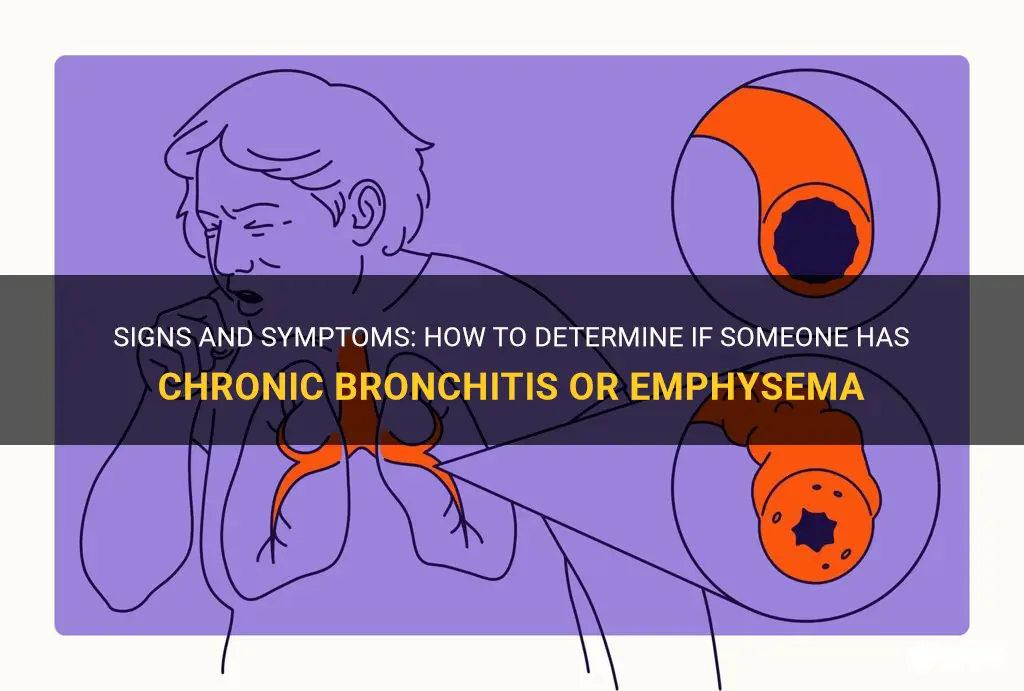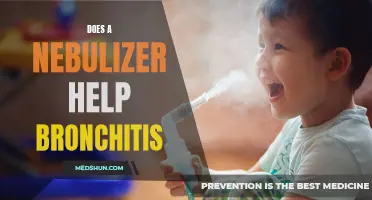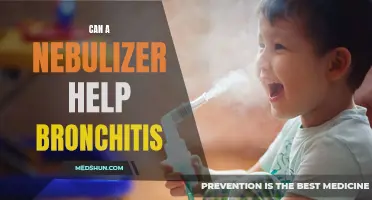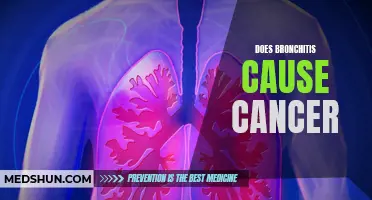
Chronic bronchitis and emphysema are two common respiratory conditions that can greatly impact a person's quality of life. While both are chronic obstructive pulmonary diseases (COPD) and share similar symptoms, there are key differences that can help distinguish one from the other. Identifying whether someone has chronic bronchitis or emphysema is crucial for proper diagnosis and treatment. In this article, we will explore the signs and symptoms to look out for to determine if someone is suffering from either chronic bronchitis or emphysema.
| Characteristics | Values |
|---|---|
| Chronic bronchitis | Production of excess mucus in the lungs |
| Persistent cough, often with a significant amount of | |
| mucus | |
| Shortness of breath | |
| Frequent respiratory infections | |
| Wheezing | |
| Fatigue or tiredness | |
| Chest discomfort or tightness | |
| Bluish lips or fingernail beds | |
| Emphysema | Shortness of breath |
| Wheezing | |
| Barrel-shaped chest | |
| Chronic cough | |
| Difficulty breathing | |
| Decreased exercise tolerance | |
| Weight loss | |
| Fatigue | |
| Frequent respiratory infections | |
| Bluish lips or fingernail beds |
What You'll Learn
- What are the common symptoms of chronic bronchitis and emphysema?
- Can a doctor diagnose chronic bronchitis and emphysema based on symptoms alone, or are further tests required?
- What are some common tests used to diagnose chronic bronchitis and emphysema?
- Are there specific risk factors or lifestyle habits that increase the likelihood of developing chronic bronchitis or emphysema?
- What are the treatment options for chronic bronchitis and emphysema, and are they effective in managing the conditions?

What are the common symptoms of chronic bronchitis and emphysema?
Chronic bronchitis and emphysema are two common types of chronic obstructive pulmonary disease (COPD). Both conditions affect the lungs and can cause significant respiratory symptoms. Understanding the common symptoms of chronic bronchitis and emphysema is crucial for early diagnosis and effective management of these conditions.
Chronic bronchitis is characterized by inflammation and irritation of the bronchial tubes, which are the airways that carry air in and out of the lungs. This inflammation leads to the production of excess mucus, causing persistent coughing and frequent respiratory infections. People with chronic bronchitis often experience shortness of breath, wheezing, and chest tightness. These symptoms tend to worsen over time and can significantly impact daily activities and quality of life.
Emphysema, on the other hand, involves the destruction of the air sacs in the lungs, called alveoli. This destruction leads to the loss of elasticity and collapse of the airways, making it difficult to exhale properly. The main symptom of emphysema is shortness of breath, which initially occurs during physical exertion but progresses to a constant feeling of breathlessness. People with emphysema may also develop a barrel-shaped chest, where the ribcage expands to accommodate extra air trapped in the lungs.
Both chronic bronchitis and emphysema share common symptoms, but the severity and progression of these symptoms can vary from person to person. It is common for individuals with these conditions to experience recurrent respiratory infections, such as bronchitis or pneumonia, due to the weakened immune system and impaired lung function. Additionally, chronic coughing is a hallmark symptom of both conditions, often accompanied by the production of thick, discolored mucus.
Other symptoms that may be present in chronic bronchitis and emphysema include fatigue, weight loss, and swelling in the ankles, feet, or legs. These symptoms can arise as a result of the increased energy expenditure required for breathing and the decreased oxygen levels in the body. Over time, the reduced lung capacity and oxygenation can lead to a bluish discoloration of the lips and fingernails, known as cyanosis.
It is essential to recognize the symptoms of chronic bronchitis and emphysema early on to seek appropriate medical attention. Proper diagnosis typically requires a detailed medical history, physical examination, and pulmonary function tests to assess lung function and airflow limitation. Treatment for chronic bronchitis and emphysema focuses on managing symptoms, slowing disease progression, and improving quality of life.
Common treatment approaches include bronchodilators, which help relax the airway muscles and improve breathing, inhaled corticosteroids to reduce inflammation, and antibiotics to treat respiratory infections. Pulmonary rehabilitation programs can also be beneficial in improving exercise capacity, reducing symptoms, and providing education and support for managing the condition. In severe cases, surgical treatments like lung volume reduction surgery or lung transplantation may be considered.
In conclusion, chronic bronchitis and emphysema are both chronic lung conditions that can cause significant respiratory symptoms. The common symptoms include persistent cough, excessive mucus production, shortness of breath, and recurrent respiratory infections. It is important to seek medical attention if any of these symptoms are present, as early diagnosis and appropriate management can help improve symptoms and slow disease progression.
Understanding the Relationship Between Cold and Bronchitis: Can You Develop Both Simultaneously?
You may want to see also

Can a doctor diagnose chronic bronchitis and emphysema based on symptoms alone, or are further tests required?
Chronic bronchitis and emphysema are both chronic obstructive pulmonary diseases (COPD) that affect the lungs and can have similar symptoms. While a doctor may suspect these conditions based on symptoms alone, a definitive diagnosis typically requires further tests to confirm the presence of chronic bronchitis or emphysema.
When a patient presents with symptoms such as cough, wheezing, shortness of breath, and a history of smoking, a doctor may initially suspect chronic bronchitis or emphysema. These conditions are characterized by inflammation and damage to the airways and alveoli in the lungs, leading to symptoms of breathing difficulty.
However, the presence of these symptoms alone is not enough to make a conclusive diagnosis. This is because other respiratory conditions, such as asthma or pneumonia, can also cause similar symptoms. In addition, there may be coexisting medical conditions or factors that contribute to the symptoms, such as heart disease or exposure to environmental pollutants.
To confirm a diagnosis of chronic bronchitis or emphysema, further tests are usually required. These tests can help assess lung function and determine the severity of the disease. Some common tests used in the diagnosis of COPD include:
- Spirometry: This test measures the amount of air a person can breathe in and out and how quickly they can exhale. It provides important information about lung function and can help differentiate between chronic bronchitis and emphysema.
- Chest X-ray: A chest X-ray can help identify any structural abnormalities or signs of lung damage. It can also help rule out other conditions, such as lung cancer or pneumonia.
- CT scan: A CT scan provides a more detailed image of the lungs and can help identify any structural changes or signs of emphysema.
- Arterial blood gas test: This test measures the levels of oxygen and carbon dioxide in the blood, providing information about lung function and gas exchange.
- Pulmonary function tests: These tests assess lung function and can help determine the extent of airflow limitation and the severity of the disease.
In some cases, additional tests may be required, such as a sputum culture to check for bacterial infections or a bronchoscopy to examine the airways more closely.
It is important for a doctor to accurately diagnose chronic bronchitis or emphysema, as the treatment and management approaches may differ. While there is currently no cure for these conditions, various interventions, such as medications, pulmonary rehabilitation, and lifestyle changes, can help manage symptoms and slow disease progression.
In conclusion, while a doctor may suspect chronic bronchitis or emphysema based on symptoms alone, a definitive diagnosis typically requires further tests. These tests help assess lung function and confirm the presence and severity of the disease. Prompt and accurate diagnosis is crucial for effective management and improved quality of life for individuals with chronic bronchitis or emphysema.
Exploring the Effectiveness of Duoneb in Managing Bronchitis Symptoms
You may want to see also

What are some common tests used to diagnose chronic bronchitis and emphysema?
Chronic bronchitis and emphysema are two common conditions that fall under the category of chronic obstructive pulmonary disease (COPD). These conditions affect the lungs and can cause significant breathing difficulties. Diagnosis of chronic bronchitis and emphysema typically involves a combination of medical history, physical examination, and various tests.
Here are some common tests used to diagnose chronic bronchitis and emphysema:
- Spirometry: This is the most common lung function test used to diagnose COPD. It measures the amount of air you can inhale and exhale forcefully. Spirometry can determine the severity of obstruction in the airways and help differentiate between chronic bronchitis and emphysema.
- Chest X-ray: A chest X-ray can reveal abnormalities in the lungs, such as hyperinflation or bullae (large air sacs). While it cannot definitively diagnose chronic bronchitis or emphysema, it can help rule out other conditions and provide additional information about the lungs.
- CT scan: A computed tomography (CT) scan provides a detailed image of the lungs and can help identify emphysema. It can also detect other conditions, such as lung cancer or pulmonary embolism, that may be causing similar symptoms.
- Arterial blood gas analysis: This test measures the levels of oxygen and carbon dioxide in your blood. It can help determine the degree of respiratory impairment and assess the severity of your condition.
- Pulmonary function tests: In addition to spirometry, other pulmonary function tests may be used to evaluate lung function. These tests include lung volume measurement, diffusion capacity, and airway resistance measurements.
- Alpha-1 antitrypsin deficiency testing: Alpha-1 antitrypsin deficiency is a genetic condition that increases the risk of developing emphysema, particularly in non-smokers. Testing for this deficiency may be recommended for people with a family history of COPD or those who develop emphysema at a young age.
It is important to note that the diagnosis of chronic bronchitis and emphysema is made based on a combination of findings from these tests, along with a thorough medical history and physical examination. The results of these tests can help guide treatment decisions and monitor disease progression.
In conclusion, the diagnosis of chronic bronchitis and emphysema involves a comprehensive evaluation, including medical history, physical examination, and various tests. Spirometry, chest X-ray, CT scan, arterial blood gas analysis, pulmonary function tests, and alpha-1 antitrypsin deficiency testing are among the most commonly used tests to diagnose these conditions. Consultation with a healthcare professional is necessary for an accurate diagnosis and appropriate management of chronic bronchitis and emphysema.
Exploring the Connection: Could Bronchitis Serve as an Indicator for COVID-19?
You may want to see also

Are there specific risk factors or lifestyle habits that increase the likelihood of developing chronic bronchitis or emphysema?
Chronic bronchitis and emphysema are both chronic respiratory diseases that fall under the umbrella term of chronic obstructive pulmonary disease (COPD). While they share some similarities, they also have distinct risk factors and lifestyle habits that can increase the likelihood of developing these conditions.
- Smoking: Perhaps the most well-known risk factor for chronic bronchitis and emphysema is smoking. Overwhelming evidence has shown that smoking tobacco increases the risk of developing these conditions. The harmful chemicals in tobacco smoke irritate and inflame the airways, leading to chronic inflammation and damage to the air sacs in the lungs. Quitting smoking is the most effective way to reduce the risk of developing these respiratory conditions.
- Environmental pollutants: Exposure to environmental pollutants, such as secondhand smoke, industrial fumes, and air pollution, also increases the risk of chronic bronchitis and emphysema. Prolonged exposure to these pollutants can lead to chronic inflammation and damage to the airways and lungs. Minimizing exposure to these pollutants, both at home and in the workplace, is essential for reducing the risk of developing these conditions.
- Genetic factors: Some individuals may have a genetic predisposition to developing chronic bronchitis or emphysema. Alpha-1 antitrypsin deficiency (AATD) is a genetic condition that can increase the risk of developing emphysema at a young age. AATD is a genetic disorder that affects the production of a protein called alpha-1 antitrypsin, which helps protect the lungs from damage. People with this deficiency are more susceptible to lung damage from smoking and other environmental factors.
- Age: Chronic bronchitis and emphysema are more commonly seen in older adults. The risk of developing these conditions increases with age, as the lungs naturally undergo wear and tear over time. Aging also leads to a decrease in lung function and a reduced ability to repair and regenerate damaged lung tissue. While age is not a modifiable risk factor, adopting a healthy lifestyle can help to mitigate the impact of aging on lung health.
- Occupational exposure: Certain occupations, such as coal mining, construction, and manufacturing, can expose individuals to harmful substances that can damage the lungs and increase the risk of chronic bronchitis and emphysema. These substances may include dust, chemicals, and pollutants. Utilizing appropriate protective measures in the workplace, such as wearing masks and ensuring proper ventilation, can help reduce the risk of lung damage.
- Socioeconomic factors: Research has shown that individuals from lower socioeconomic backgrounds may be at a higher risk of developing chronic bronchitis and emphysema. Factors such as poor access to healthcare, limited education, and living in areas with higher levels of pollution can contribute to this disparity. Addressing these socioeconomic factors is crucial in reducing the burden of respiratory diseases among disadvantaged populations.
- Respiratory infections: Frequent respiratory infections, such as recurring colds or pneumonia, can also contribute to the development of chronic bronchitis and emphysema. These infections can cause inflammation and damage to the airways, leading to long-term respiratory problems. Practicing good hygiene, getting vaccinated against respiratory infections like influenza and pneumonia, and avoiding close contact with sick individuals can help reduce the risk of developing these conditions.
In conclusion, several risk factors and lifestyle habits contribute to an increased likelihood of developing chronic bronchitis and emphysema. Smoking, exposure to environmental pollutants, genetic factors, age, occupational exposure, socioeconomic factors, and frequent respiratory infections all play a role in the development and progression of these chronic respiratory diseases. Making healthy lifestyle choices, such as quitting smoking, minimizing exposure to pollutants, and practicing good hygiene, can significantly reduce the risk of developing these conditions and improve overall lung health.
Understanding the Link Between Bronchitis and Fever in Babies
You may want to see also

What are the treatment options for chronic bronchitis and emphysema, and are they effective in managing the conditions?
Chronic bronchitis and emphysema are both chronic obstructive pulmonary diseases (COPD) that affect the lungs. These conditions can cause significant impairment of lung function and can have a significant impact on a person's quality of life. Fortunately, there are several treatment options available that can help manage the symptoms of chronic bronchitis and emphysema.
The primary goal of treatment for chronic bronchitis and emphysema is to improve lung function, relieve symptoms, and prevent further progression of the disease. One of the most effective ways to accomplish this is by quitting smoking. Smoking is the leading cause of chronic bronchitis and emphysema, and quitting smoking can have a significant impact on the progression of these conditions.
In addition to smoking cessation, there are several other treatment options that can be effective in managing chronic bronchitis and emphysema. One of the most common treatments is the use of bronchodilators. These medications work by relaxing the muscles in the airways, which helps to open them up and improve airflow. Bronchodilators can be taken orally as pills or inhaled through a device called an inhaler.
Another commonly used treatment for chronic bronchitis and emphysema is corticosteroids. These medications help reduce inflammation in the airways, which can help relieve symptoms and improve lung function. Corticosteroids can be taken orally as pills or inhaled through an inhaler.
Pulmonary rehabilitation is another important treatment option for chronic bronchitis and emphysema. Pulmonary rehabilitation involves a combination of exercise, breathing exercises, and education about managing symptoms and improving lung function. This can be done in a structured program led by healthcare professionals or on an individual basis at home with guidance from a healthcare provider.
In some cases, supplemental oxygen therapy may be necessary to help manage chronic bronchitis and emphysema. Supplemental oxygen can help improve oxygen levels in the blood and reduce shortness of breath. It can be used continuously or during activities that cause shortness of breath.
Surgery is an option for some individuals with severe chronic bronchitis or emphysema. Lung volume reduction surgery involves removing damaged areas of the lung, which can help improve lung function and relieve symptoms. Lung transplantation may also be considered for individuals with end-stage chronic bronchitis or emphysema.
It is important to note that while these treatment options can be effective in managing chronic bronchitis and emphysema, they cannot cure the conditions. The goal of treatment is to slow the progression of the disease, manage symptoms, and improve quality of life. It is also important for individuals with chronic bronchitis and emphysema to take steps to prevent flare-ups, such as avoiding respiratory irritants and getting vaccinated against respiratory infections.
In conclusion, there are several effective treatment options available for individuals with chronic bronchitis and emphysema. These treatment options include smoking cessation, bronchodilators, corticosteroids, pulmonary rehabilitation, supplemental oxygen therapy, and, in some cases, surgery. While these treatments cannot cure chronic bronchitis and emphysema, they can help manage symptoms and improve lung function. It is important for individuals with these conditions to work closely with their healthcare providers to develop a treatment plan that is tailored to their specific needs.
Can You Simultaneously Have Bronchitis and COVID? Exploring the Possible Coexistence
You may want to see also
Frequently asked questions
One common symptom of chronic bronchitis is a persistent cough that produces mucus. The cough may last for at least three months and occur on most days for at least two consecutive years. Individuals with emphysema often experience shortness of breath, especially during physical activity. They may also have a chronic cough, wheezing, and chest tightness.
Yes, there are several tests that can help confirm a diagnosis of chronic bronchitis or emphysema. Pulmonary function tests, such as spirometry, can measure lung function and detect airflow obstruction. A chest X-ray or CT scan may also be used to evaluate the lungs and rule out other conditions. In some cases, a blood test may be performed to check for elevated levels of certain proteins, which can indicate lung damage.
The primary risk factor for both chronic bronchitis and emphysema is cigarette smoking. Other factors that can increase the risk include exposure to secondhand smoke, air pollution, and occupational exposure to certain chemicals and dusts. Genetic factors may also play a role, as some individuals may be predisposed to developing these conditions. It is important to note that quitting smoking and avoiding exposure to harmful substances can help reduce the risk of developing chronic bronchitis or emphysema.







